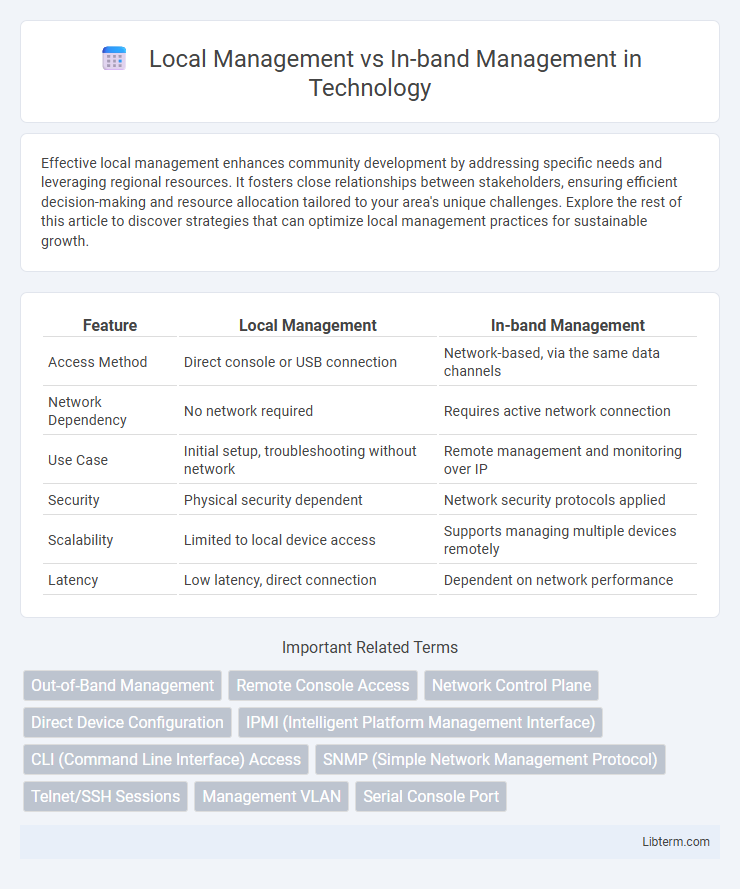Effective local management enhances community development by addressing specific needs and leveraging regional resources. It fosters close relationships between stakeholders, ensuring efficient decision-making and resource allocation tailored to your area's unique challenges. Explore the rest of this article to discover strategies that can optimize local management practices for sustainable growth.
Table of Comparison
| Feature | Local Management | In-band Management |
|---|---|---|
| Access Method | Direct console or USB connection | Network-based, via the same data channels |
| Network Dependency | No network required | Requires active network connection |
| Use Case | Initial setup, troubleshooting without network | Remote management and monitoring over IP |
| Security | Physical security dependent | Network security protocols applied |
| Scalability | Limited to local device access | Supports managing multiple devices remotely |
| Latency | Low latency, direct connection | Dependent on network performance |
Defining Local Management
Local Management refers to directly configuring and controlling network devices on-site through physical access or a dedicated console port, ensuring immediate response and secure administrative control without relying on network connectivity. This method contrasts with In-band Management, which uses the regular network data channels for device administration, exposing management traffic to potential network disruptions or security risks. Local Management is essential for initial device setup, troubleshooting, and recovery when remote access fails or is unavailable.
Understanding In-band Management
In-band management utilizes the same network channel used for regular data traffic to monitor and configure devices, offering cost efficiency and simplified infrastructure. This approach allows administrators to manage systems remotely through the existing network without requiring additional management interfaces. However, in-band management relies heavily on network availability and can be vulnerable to network failures or security breaches affecting the management access.
Key Differences Between Local and In-band Management
Local management provides direct access to network devices through physical connections such as console ports, ensuring secure and reliable access during device failures. In-band management relies on the network itself, using protocols like SSH or Telnet over Ethernet, which can be vulnerable during network outages. Key differences include access method, dependency on network availability, and security risk, with local management offering out-of-band control independent of network status.
Advantages of Local Management
Local management offers enhanced security by restricting network device access to on-site administrators, reducing exposure to external threats. It enables faster troubleshooting and maintenance with direct physical access, eliminating dependency on network connectivity. Local management also ensures reliable configuration and control during network outages when in-band management may become inaccessible.
Benefits of In-band Management
In-band management enables remote access to network devices through the same network used for data transmission, reducing the need for additional hardware and lowering operational costs. It streamlines troubleshooting and configuration by allowing administrators to manage devices from any location with network connectivity, enhancing efficiency and responsiveness. This method supports continuous monitoring and real-time updates, improving overall network reliability and simplifying maintenance workflows.
Security Implications of Both Management Methods
Local management secures device access by restricting control to a directly connected terminal, minimizing exposure to network-based attacks but risking physical tampering threats. In-band management relies on network connectivity, enabling remote device control with encryption protocols like SSH or HTTPS, which can be vulnerable to interception or unauthorized access if not properly secured. Both methods require strict authentication and access controls to mitigate risks, with local management favoring isolation and in-band management offering flexibility but necessitating robust network security measures.
Network Performance and Accessibility Considerations
Local management offers direct device control via physical interfaces, ensuring low latency and high network performance by isolating management traffic from the main data path. In-band management uses the same network channels as regular data, potentially affecting accessibility during network congestion or failures and increasing latency. Choosing between local and in-band management depends on balancing the need for uninterrupted access against network resource utilization and operational complexity.
Use Cases for Local Management
Local management provides direct access to network devices through physical interfaces such as console ports or dedicated management ports, making it indispensable for initial device setup, troubleshooting during network outages, and secure configuration tasks in isolated environments. It is widely used in scenarios where remote connectivity is unavailable or unreliable, such as in data centers, branch offices, and industrial networks requiring high security and minimal latency. Local management ensures administrators can maintain control over critical infrastructure without dependency on network-based protocols, enhancing operational resilience.
Scenarios Favoring In-band Management
In-band management is ideal for scenarios where remote access to network devices is necessary without physical presence, such as managing geographically dispersed data centers or branch offices. It simplifies operations by using the existing network infrastructure to perform configuration, monitoring, and troubleshooting tasks. This approach is cost-effective and efficient in environments with reliable network connectivity and redundancy measures.
Choosing the Right Management Approach for Your Network
Local Management offers direct device configuration through console ports, ideal for secure, on-site control and troubleshooting in isolated networks. In-band Management utilizes the existing network infrastructure for remote device administration, providing convenience and scalability for managing multiple devices across dispersed locations. Selecting the right management approach depends on network size, security requirements, and operational needs, balancing immediacy of access with centralized control efficiency.
Local Management Infographic

 libterm.com
libterm.com